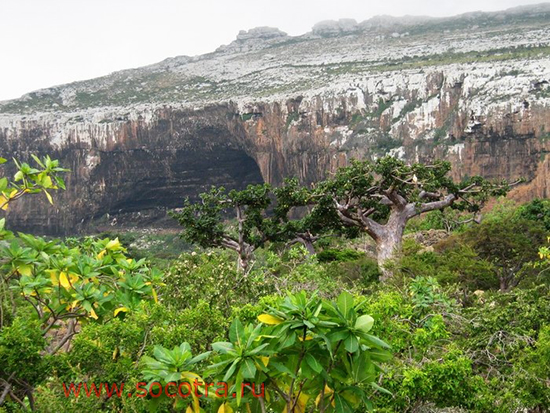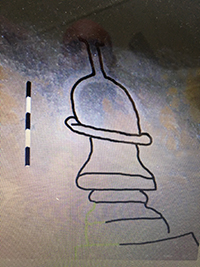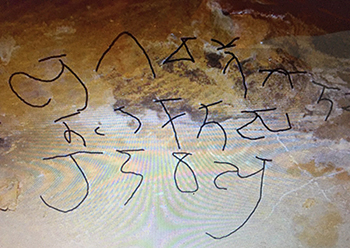WHEN ANCIENT BUDDHISTS SAILED WEST-by Bhante Dhammika of Australia

Source:Island
One of the most isolated and little-known places in the world is the island of Socotra. Dry, barren and with only a small population, it sits some 380 kilometres off the southern edge of the Arabian Peninsula and the eastern tip of Somalia and is now administered at part of Yemen. Although on one of the world’s busiest shipping lanes it has no port facilities and gets almost no visitors. Nonetheless, it has recently become one of the most important and unexpected archaeological sites for those interested in Indian and particularly Indian Buddhist history.

In the year 2000 a group of Belgian speleologist (Speleology is the study of caves) visited a large cave on Socotra known by the locals as Hoq and made a series of remarkable discoveries. The cave itself is on the northern coast of the island facing out to sea and not only has a wide opening but is more than two kilometer deep and in parts 35 meters high. On the walls of the passage leading to the back of the cave, the cavers discovered to their astonishment a large number of very ancient drawings, inscriptions and graffiti. Careful study of this material since then has shown that the majority of these were made by ancient Indian merchants travelling to and from the Red Sea and beyond. It has long been known that in ancient times merchants travelling from Indian ports such as Sopara, Kalyana and Chaul to the Middle East and further on to Egypt and even sometimes to Rome, passed by and often stopped at Socotra but this is the earliest material evidence of such travelers.
A look at a map will show that the direct and quickest route from ports on the India’s west coast across the Arabian Sea to the mouth of the Red Sea (i.e. Aden) would pass by Socotra. The drawings graffiti and inscriptions in the cave were made with material the visitors would have picked up on the spot – clay, mud and charcoal, probably from torches they carried. So far, 193 inscriptions have been found, one is in Khroasthi and the rest are in various forms of Brahmi and date from the 1st to the 5th centuries CE. Judging from the style (paleography) of the Brahmi scripts used, it would seem that those who wrote them came mainly from Gujarat and the western Deccan. Several of the writers describe themselves as “of Bharukaccha” meaning that they were from the town now called Bharuch which was a port often mentioned in the Jataka. For example, according to the Supparaka Jataka (No. 463) the Bodhisattva was once born into a merchant family from the town.
Many of the visitors to the Hoq Cave also identify themselves as ‘navika’ and ‘naryamaka’ both maritime titles. But perhaps the most interesting thing about the drawings, inscriptions and graffiti is how many of them were written and drawn by Buddhists. This is clear from some of the names mentioned – Buddhanandin, Saṃghadāsa son of Jayasena from Hastakavapra, Saṃghanandin, Buddhasakya and Dharma. Amongst the patronyms are Buddhamitra father of Bhaṭṭikumara, Dharma father of Halla and Saṃgharangin father of Ajitivarman The name Asoka occurs twice, once as the writer’s name and once as a father’s name. Having the name Asoka is not clear proof of a Buddhist background but it is likely.
A second group of inscriptions do not include specific Buddhist names but make direct reference to the religion. Someone named Rahavasu wrote: “For the Lord, the Great Sage” (Bhagavato mahamuṇi), a phrase that would be familiar to some Buddhists even today. Another inscription written by the same Rahavasu reads: “Lord Gotama the Lion.” Perhaps the most remarkable records left by these Buddhist travelers are two drawings of stupas made in the sand on the floor of the cave. Despite being made over 1500 years ago the images are still clear, unaffected by time and the footprints of later visitors to the cave. Beside one stupa is the name of the man who made it, Isaradasa, which is a distinctly Hindu name. It is possible that he worshiped both the Buddha and Siva or that he was a convert to Buddhism. It would seem likely that the stupas were made in order to be the focus of a puja.

Two other inscriptions in the cave deserve special notice because they may have been made by monks. Of five inscriptions made by an individual named Dhruva, one of them includes the words ‘srama[ṇa]sya ma.….’ The end of this inscription cannot be read and the meaning of the part that can be is obscure. But of course ‘samana’ is an alternative word for bhikkhu, i.e. a monk. The second inscription is also obscure but less so. With some reservations it could read “The Saka monk has come here” (sakasramaṇo āga[to]). Saka was the name given to the Indo-Scythian people who migrated into India from the 2nd BCE century onwards. However, it is also possible that Saka could be a version of Sakya and of course Buddhist monks and nuns were commonly called Sakyans, i.e. sons of the Sakyan (Sakyaputta), i.e. the Buddha. Evidence from India dating from the Vinaya onwards tells us that Buddhist monks often linked up with merchants’ caravans and travelled with them. It is possible that these two inscriptions are evidence of monks travelling with seafaring merchants to lands far beyond India.
Many questions about the Buddhist visitors to the Hoq Cave remain to be answered. Did they just make short trips to the cave or did they reside there for extended periods, perhaps waiting for the monsoon winds to carry them on their way? Why did they leave the things they wrote or drew in the cave’s deep, utterly dark interior rather than in the wide and airy opening? It will take scholars years to write the full story of the cave and its visitors.
In his edict of the year 256 BCE King Asoka mentioned the Buddhist missions he had dispatched to Syria, Egypt, Macedonia, Cyrene (modern Libya) and Epirus (modern western Greece). However, it is not known if these monks ever reached their destinations – the project may have been abandoned half way through or met with disaster. And there is no records from the lands they were sent to of their arrival and no evidence of any impact they may have had. In popular writing and internet sites it is often claimed that there was a Buddhist monastery in Alexander, the great cosmopolitan city in Egypt. There is however, no evidence either literary, epigraphical or archaeological of this. It is known that Indians settled in places such as Myos Hormos and Berenike on the Red Sea coast but no archaeological evidence of their presence has so far been found and of the several Indian inscriptions found on the coast none mention Buddhism.
The first explicit evidence we have of a Western knowledge of Buddhism is comments made by the Christian theologian Clement of Alexandria, who lived in the late second or early third century CE. Did he have direct contact with Buddhists or people who had direct contact with them? Did he come to know of Buddhism from second-hand information he heard from travelling merchants or diplomats? The truth is that we simply do not know. It is not even certain that the two inscriptions from the Hoq Cave that include the word ‘samana’ refer to monks, and even if they do this would not prove that the monks got to as far as Egypt. Nonetheless, the recent discoveries from Socotra do prove that Buddhists played an important part in the movement of goods and possibly ideas from east to west in ancient times.







